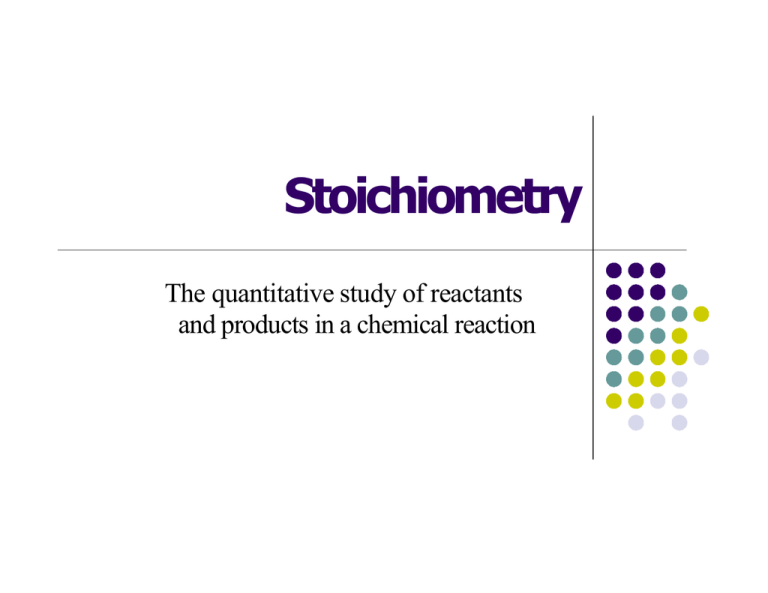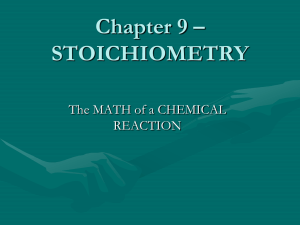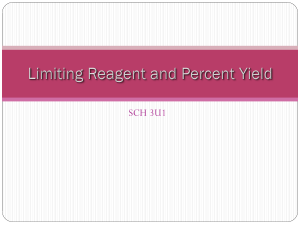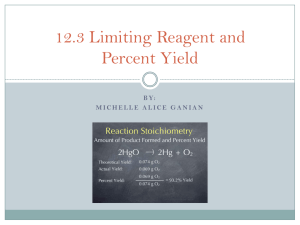Stoichiometry
advertisement

Stoichiometry The quantitative study of reactants and products in a chemical reaction Stoichiometry Whether the units given for reactants or products are moles , grams , liters (for gases), or some other units, we use moles to calculate the amount of product formed in a reaction Stoichiometry Mass Mass Moles Liters Particles Known Moles Liters Particles Unknown Review before starting Dimensional Analysis Conversion Factors The Mole Molar Conversions Balancing Chemical Equations Stoichiometry Problem Types Mole to Mole Mole to Mass & Mass to Mole Mass to Mass Volume to Moles or Mass Limiting Reactants & Per Cent Yield Mole to Mole An example problem If we have 4 moles of CO and abundant O2 How many moles of CO2 will be produced? 4 moles CO(g) known 2 CO(g) + O2 ? Moles CO2(g) unknown 2 CO2(g) The Balanced Equation 2 CO(g) + O2 --> 2 moles 1 mole 2CO2(g) 2 moles Coefficients show relative amounts Limiting Reagents To make a dozen brownies the recipe calls for 2 cups flour, 112 grams chocolate, 25O ml water . You have 2 cups flour 50 grams chocolate, & 250 ml water If you want to make quality brownies you will make less than a dozen and have flour & water left over! What is the limiting reagent ? Limiting Reagents Zinc & Sulfur react to form zinc (II) sulÞde according to the following equation 8 Zn(s) + S8 8ZnS(s) If 2.00 mol of Zn are heated with 1.00 mole S 8, identify the limiting reactant. How many moles of excess reactant will there Percent Yield So far we have been doing stoichiometry problems that represent theoretical yields Actual Yield - the measured amount of product that you really get in the reaction. Percent Yield Percent Yield is the ratio of the actual yield to the theoretical yield multiplied by 100 Percent yield = actual yield theoretical yield x 100 Percent Yield Quicklime, CaO, can be prepared by roasting limestone, CaCO3, according to the following reaction. CaCO3(s) CaO(s) + CO2(g) When 2.00 x 1 03g of CaCO3(s) is heated the actual yield of CaO is 1.05 x 1 03g. What is the percent yield? 2.00 x 103g CaCO3(s) Use Molar ratio Divide by molar mass Moles Multiply by molar mass Divide by molar mass Multiply by molar mass Divide 6.022 x 1023 Use Molar Ratio Volume Multiply 3 When 2.00 x 1 0 byg22.4of of gas CaCO3(s) is heated the actual yield of CaO is 1.05 x 1 03g. What is the percent yield? Mass in grams Multiply 6.022 x 1023 Moles Divide by 22.4 # of particles Volume of gas Percent Yield CaCO3(s) CaO(s) + CO2(g) Given: 2.00 x 1 03g of CaCO 3(s) actual yield of CaO is 1.05 x 1 03g To solve 1. Find theoretical yield (mass mass problem) 2. Find percent yield (actual/theoretical x 1 00) 2.00 x 1 0 3g CaCO 3(s) 1 mol CaCO3 100.g 1 mol CaO 56.0 g 1 mol CaCO 3 1 mol CaO = 11 20g CaO Percent Yield = 1.05 x 10 3g x 100 = 93.8% 1.12 x 103g











